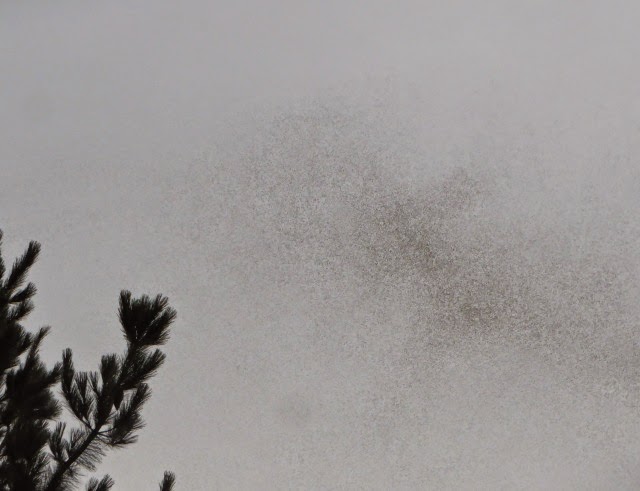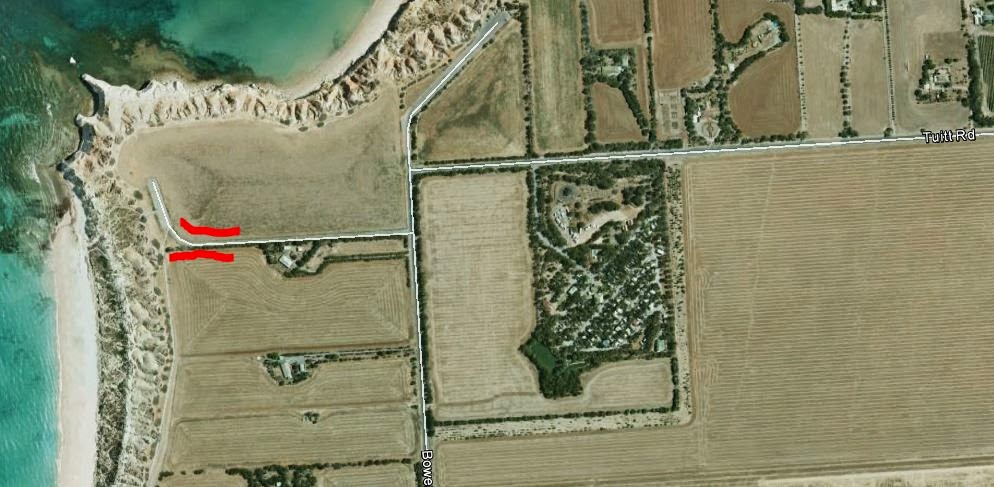ANPS does the Tinderries (part 1)
On 23 January we finally made it to the Tinderries after a delay due to concerns about heat and fire risk the previous week. It was a top walk (in the sense of being very enjoyable as well as covering the top of the range). This post covers plants, birds and general topics while the insects use up so many images they have earned their own post. As this one still ends up with 22 images I shall try to cut down the blather and let you look at some flowers etc.
I was going to say "pretty flowers" but then looked at this first image of the surrounds of Michelago Railway Station where we met for car pooling. Some contractors were spraying noxious weeds along the railway line but the fire hazard of this metre high grass appears to be ongoing.
On the matter of fires, the area we were visiting was obliterated by a huge fire in December 2009. As shown below much of the bush is regenerating both through germination in the soil and epicormic growth.
On the granite tops, without much top soil (there never was, and I suspect the fires and wind removed a fair bit of what was there) a moonscape is still available!
Despite the impact of the fires and the dry period we are currently enduring, there was still water running out of the hanging swamp we visited near the top, and in the second swamp on Round Flat Fire Trail.
On to the plants. These are pretty much in the order in which we saw them, starting with some roadside specimens on the highest point.
We then transported ourselves a few kms down the road to the Round Flat Fire Trail. This Ozomanthus stirlingii was an addition to the site list.
The flat bit of this trail is occupied by a swamp. If there was a Committee for UnAustralian Activities going out into a swamp with metre high vegetation in mid Summer would probably earn a major award (the Gold Crossed Reptiles?) from them. However only one snake was seen and - more importantly - none were felt.
Some seed heads of some monocotyledon with a ghostly goat (a ghoat? goast?) behind it, showing a nice pair of horns.
A fungus has set up home on/in a burnt trunk.
There weren't a lot of birds around but the Dusky Woodswallows on the Round Flat trail were good. One member of the group reported seeing them entering a nest hollow which is good!
The strangest avian interlude was the behaviour of 4 Pallid Cuckoos. Which were flying around calling loudly at each other. Such behaviour could be considered breeding display but it seems a bit late in the year, even allowing for the later season at 1200m elevation. Here is a back view of one participant ...
.. and a front-on, open beak, view of another.
I was going to say "pretty flowers" but then looked at this first image of the surrounds of Michelago Railway Station where we met for car pooling. Some contractors were spraying noxious weeds along the railway line but the fire hazard of this metre high grass appears to be ongoing.
On the matter of fires, the area we were visiting was obliterated by a huge fire in December 2009. As shown below much of the bush is regenerating both through germination in the soil and epicormic growth.
On the granite tops, without much top soil (there never was, and I suspect the fires and wind removed a fair bit of what was there) a moonscape is still available!
Despite the impact of the fires and the dry period we are currently enduring, there was still water running out of the hanging swamp we visited near the top, and in the second swamp on Round Flat Fire Trail.
On to the plants. These are pretty much in the order in which we saw them, starting with some roadside specimens on the highest point.
Lomatia myricoides
Stylidium graminifolium
Platysace lanceolata
Baeckea utilis
Moving into the swamp a little further down the road there was (almost) a carpet of Utricularia dichotoma.
Arthropodium milleflorum (aka Vanilla lily)
The only orchids seen today were some Microtis sp. I am not game to try to add a species name to them!.
Drosera peltata
Getting back to the roadside we found many Wahlenbergia gloriosa, the so-called "Royal Bluebell". These were quite small specimens but still attractive. You may well ask why the floral emblem of the ACT is growing some kilometres out of that Territory! The answer appears to be that its shape was easy for logo designers to work with! (Although apparently it is a bugger to try to match the colour precisely.)We then transported ourselves a few kms down the road to the Round Flat Fire Trail. This Ozomanthus stirlingii was an addition to the site list.
The flat bit of this trail is occupied by a swamp. If there was a Committee for UnAustralian Activities going out into a swamp with metre high vegetation in mid Summer would probably earn a major award (the Gold Crossed Reptiles?) from them. However only one snake was seen and - more importantly - none were felt.
Geranium neglectum
Olearia glandulosa
Olearia ramulosa var. stricta (This is open to a little doubt and a sample has been submitted to the Herbarium for a definitive word.)Some seed heads of some monocotyledon with a ghostly goat (a ghoat? goast?) behind it, showing a nice pair of horns.
A fungus has set up home on/in a burnt trunk.
There weren't a lot of birds around but the Dusky Woodswallows on the Round Flat trail were good. One member of the group reported seeing them entering a nest hollow which is good!
The strangest avian interlude was the behaviour of 4 Pallid Cuckoos. Which were flying around calling loudly at each other. Such behaviour could be considered breeding display but it seems a bit late in the year, even allowing for the later season at 1200m elevation. Here is a back view of one participant ...
.. and a front-on, open beak, view of another.

























Comments